Hey readers!
Are you dreaming of creating a website like Amazon? Maybe you’ve read through several blogs already, all trying to piece together the secrets behind Amazon’s ecommerce dominance.
Here’s the good news! In this blog, you’ll find an in-depth, step-by-step guide that takes you from ideation to launch, offering everything you need to know how to build multi vendor ecommerce website like amazon.
If you’ve ever wondered how to make a website like Amazon, this guide will show you exactly what steps to follow.
But why is Amazon the best example?
What makes it the leader in ecommerce? Here’s why
Brand Value – According to statista, In 2024, Amazon’s brand value reached $577 billion, growing 23% in just one year and nearly 100 times more since 2006
Market Share – According to seo.ai, By 2025, Amazon is expected to control 40.9% of the U.S. ecommerce market, with over 315 million active customers worldwide
Amazon has become synonymous with trust, innovation, and convenience, reaching customers worldwide.
Ready to explore how they secured their #1 spot? Let’s break it down in the next section and learn how to start an ecommerce business like Amazon!
Key Takeaways On How To Make A Website Like Amazon
- To succeed in ecommerce, learn from Amazon’s success formula, which includes a user-friendly approach, innovation, flexible payments, and transparency, Apply these principles to understand how to make a website like Amazon.
- How to make a website like amazon, follow 8 essential steps business plan, platform, domain, MVP, UX/UI, logistics, vendor onboarding, and launch.
- Key features to make a website like amazon include vendor management system (VMS), commission systems, product management, order management, and customer profiles.
- Common challenges to make a website like amazon include competition, buyer/seller satisfaction, security, trends, and seasonal demand, which can be addressed with strategic planning and innovation.
- To successfully make a website like amazon, focus on building a multi-vendor marketplace with advanced tools, a seamless experience, and continuous innovation to stay ahead of competitors.
8 Steps Guide On How To Make a Website Like Amazon
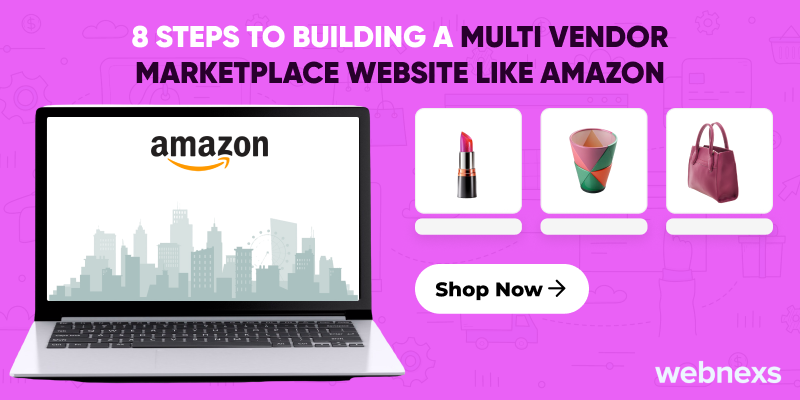
Building a multi vendor marketplace like Amazon involves more than just creating a platform it’s about offering a seamless experience for both buyers and sellers, ensuring security, and continuously evolving. In this guide, we’ll break down the 8 crucial steps to help you make an ecommerce website similar to Amazon successfully.
Step 1- Create a Business Plan and Identify Your Niche

Before you explore to building ecommerce platform like amazon, take time to create a solid business plan. This step will lay the foundation for everything else you do.
- Identify your niche
You need to know exactly what your marketplace will offer and who your target audience is. For example, Amazon started as a book marketplace before expanding into other products.
- Market research
Analyze competitors and consumer demand. Look at existing players, including Amazon, to see where your niche can add value.
- Revenue model
Decide how you will generate revenue. Will it be through listing fees, commissions, subscriptions, or a combination?
Strategic Recommendation – A clear niche and revenue model can give your marketplace a competitive edge. Don’t try to serve everyone; focus on solving specific pain points for your target customers.
Step 2- Choose the Right Marketplace Platform

Selecting the right platform is critical for your ecommerce website like Amazon to succeed. Your platform is the backbone of your online business.
- Custom or Ready-made solution?
Custom marketplace development offers complete control and flexibility. Some platforms, like Webnexs, provide successful solutions for unique business needs. Meanwhile, ready-made software like Wcart offers a cost-effective alternative.
- Scalability
Make sure your platform can handle growth. Amazon’s platform scales effortlessly as the number of vendors and products grows.
- Security
Ensure your platform supports high-level encryption, secure payment methods, and strong data protection.
Strategic Recommendation – Opt for platforms that offer easy scalability, strong security features, and flexibility for future growth. Consider integrating a content management system (CMS) to manage vendors, customers, and transactions smoothly.
Step 3- Register a Domain and Establish Branding

Your domain name is the first impression customers will have of your marketplace, so make it memorable and relevant.
- Domain name
Keep it short, easy to remember, and related to your niche.
- Branding
Design a logo, select a color scheme, and create a voice for your brand. Consistent branding helps build trust with both buyers and sellers.
- Trademark
Ensure your brand name and logo are legally protected to avoid future conflicts.
Strategic Recommendation – Building a recognizable brand helps you stand out from competitors and establishes credibility, encouraging users to trust your marketplace.
Step 4- Develop a Minimum Viable Product (MVP)
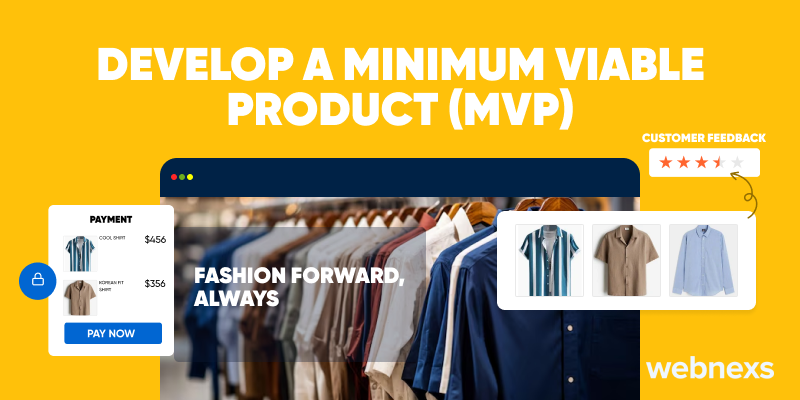
Launching with a Minimum Viable Product (MVP) ensures that you get your marketplace up and running without overwhelming yourself with unnecessary features.
- Focus on core features
Include essential functions like product listings, vendor management, secure payments, and customer support.
- Test and validate
Launch your MVP to a small audience, get feedback, and iterate based on real user experiences. This way, you avoid building features that customers don’t want.
Strategic Recommendation – Start small, learn from user feedback, and refine your marketplace. The MVP approach reduces costs and helps prioritize features that add value.
Step 5- Design a Seamless and User-Friendly Interface (UX/UI)

The user experience (UX) and user interface (UI) of your marketplace will determine how easily customers and vendors navigate your platform.
- Simplicity is key
Amazon’s simple design enables both novice and experienced users to find products and navigate the platform effortlessly.
- Mobile-first
Since most users browse and shop on mobile devices, ensure your site is fully responsive.
- Easy checkout
Streamline the checkout process to reduce cart abandonment.
Strategic Recommendation – Design with the user in mind. Your platform should offer easy navigation, fast load times, and a smooth, intuitive experience on both desktop and mobile.
Step 6- Implement Logistics and Secure Payment Gateways
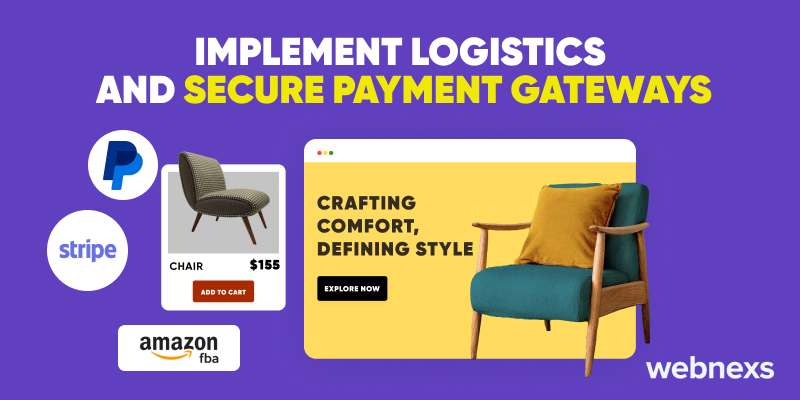
Logistics and secure payment systems are the core of any successful multi vendor marketplace.
- Logistics
Decide how orders will be fulfilled. Will you manage the logistics or rely on vendors? For example, Amazon’s Fulfillment by Amazon (FBA) simplifies order management and shipping.
- Secure payments
Implement trusted payment gateways like PayPal, Stripe, or credit card processors that guarantee safe transactions for both buyers and sellers.
- Fraud prevention
Utilize anti-fraud measures and encryption to protect sensitive data.
Strategic Recommendation – Streamline logistics and implement secure payment systems to build trust with customers and vendors. Fast and safe delivery is essential for customer satisfaction.
Step 7- Onboard Vendors and Populate Your Marketplace

Now that your ecommerce website like amazon is ready, it’s time to onboard vendors and populate your marketplace with a variety of products.
- Easy registration
Create a seamless vendor registration process. Include features that make it easy for vendors to upload products, set prices, and manage their inventory.
- Quality control
Ensure vendors meet quality standards to maintain customer satisfaction. Implement a review system for customers to leave feedback on products and sellers.
- Vendor support
Provide resources and support to help vendors grow their businesses on your platform.
Strategic Recommendation – Attract vendors by offering incentives, such as lower fees or more exposure. Build strong relationships with your vendors to ensure their long-term success on your platform.
Step 8- Launch, Market, and Scale Your ecommerce website similar to amazon

Once everything is set up, it’s time to launch your marketplace However, the real work begins with marketing and scaling your platform.
Here are some marketplace marketing guide,
- Pre-launch marketing
Build anticipation through social media, email campaigns, and teasers to attract your first customers and vendors.
- SEO and content marketing
Optimize your platform for search engines and create valuable content that helps your marketplace rank high in search results.
- Paid advertising
Consider paid campaigns on Google and social media to drive traffic to your platform.
- Scaling
As you gain traction, reinvest in technology, hire a support team, and explore global markets.
Strategic Recommendation – Use digital marketing strategies like SEO, social media, and email marketing to boost traffic. Focus on continuous optimization and scaling to reach more vendors and customers.
Learn How to Make a Website like Amazon with webnexs.
Why is Amazon So Popular Among Sellers and Buyers?
Let’s talk about how Amazon became the biggest online ecommerce marketplace in the world it’s pretty inspiring! It didn’t happen overnight; it took a lot of steady innovation, keeping customers happy, and smart choices. Jeff Bezos kicked things off in 1994, starting with just an online bookstore, but it quickly grew into a multi-billion-dollar ecommerce giant.
Now, let’s dive in and explore how they achieved this through their winning formula for buyer and seller loyalty.
Come on, let’s see!
Amazon’s Winning Formula for Buyer and Seller Loyalty
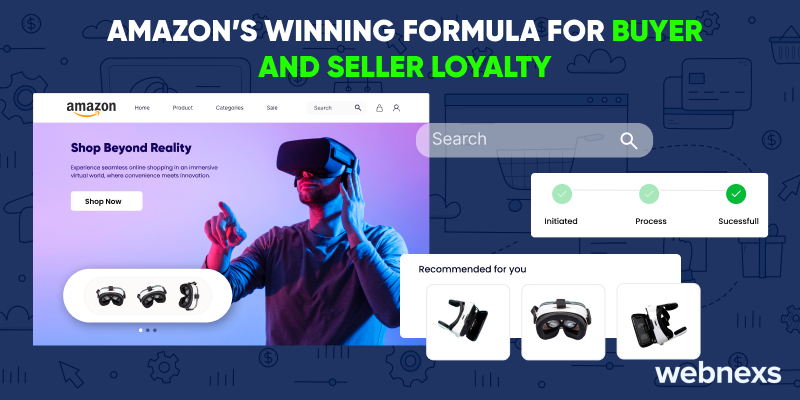
The key to Amazon’s success is how well it meets the needs of both buyers and sellers. Let’s explore the main reasons behind its popularity
1. The Power of a User-Centric Approach
One of the biggest reasons Amazon became a global leader is its continuous focus on the user experience. From the beginning, Amazon prioritized customers’ needs over everything else, creating a convenient and customer-friendly environment.
Why Did Amazon Focus on This?
Amazon’s user-centric approach focuses on making shopping as easy as possible. This includes,
- Easy Navigation
Ensuring customers can quickly find what they need.
- Fast Checkout
Streamlining the checkout process to minimize effort.
- Personalized Experience
Recommending products based on browsing history, making it easier for customers to discover what they want.
How Did This Help Amazon?
According to a study by the Gartner Group, improving customer experience can boost revenue by up to 10-15% annually. For Amazon, this approach has contributed massively to customer retention and brand loyalty, leading to billions in revenue year after year.
2. Continuous Innovation in Design and Technology
Innovation is at the heart of Amazon’s success. The company has always used new technology to improve its services and offerings.
Why Does Amazon Invest in Technology?
Amazon’s tech stack includes artificial intelligence (AI), augmented reality (AR), and even virtual reality (VR). These technologies aren’t just flashy; they solve real problems for both buyers and sellers.
- AI
Personalized product recommendations based on past behavior increase sales and help customers find products they might not have thought of.
- AR
This allows customers to virtually “try” products like furniture or clothes before buying, enhancing the shopping experience.
Impact of Technology on Amazon’s Success
According to CRN, During Amazon’s Q1 2024 earnings report, CEO Andy Jassy highlighted that generative AI contributed significantly to AWS’s 17% year-over-year sales growth, reaching $25 billion.
3. Flexible Payment and Return Options
Customers want peace of mind when they shop online, and Amazon has taken care of this through its easy return policies and wide range of payment options. this strategy attract more customers.
What Makes Amazon’s Payment and Return Policies Stand Out?
- Multiple Payment Methods
From credit cards and digital wallets to Amazon Pay, the flexibility ensures no one is left behind.
- Easy Returns
Amazon offers a straightforward returns policy, allowing customers to return items with no hassle.
Why Did Amazon Focus on These?
It’s simple! customers are more likely to purchase if they know they can return a product easily. According to Business2Community, 87% of online shoppers in the U.S. in 2022 considered free return policies important when making purchases. This highlights the value customers place on convenience and transparency in ecommerce websites like Amazon.
How Does This Impact Amazon’s Success?
This approach has been crucial to Amazon’s retention rate, which, according to Epsilon, is 80% higher than many competitors due to the trust it builds with customers.
4. Transparent Business Model
One of Amazon’s key strengths is its transparent business model. Unlike many platforms that have hidden fees, Amazon makes its pricing structure crystal clear for both buyers and sellers.
Why Is Transparency Important?
Amazon’s transparency helps build trust. Both buyers and sellers know exactly what to expect in terms of fees, shipping charges, and policies. There are no hidden costs or complex terms to navigate.
How Does This Benefit Amazon?
According to Eva.guru – As of February 2023, Amazon Transparency has more than 1 million sellers and 750 million products enrolled. This helps build trust by verifying products for customers.
Each of these strategies has contributed to Amazon’s incredible success, from ensuring a smooth shopping experience to maintaining a safe and trustworthy platform.
As more businesses look to replicate Amazon’s success by creating a multi-vendor marketplace website like Amazon, these are the key takeaways that can help them succeed in the competitive world of ecommerce websites.
Take the First Step to Make a Website Like Amazon
Essential Features for Multi Vendor Marketplace Success
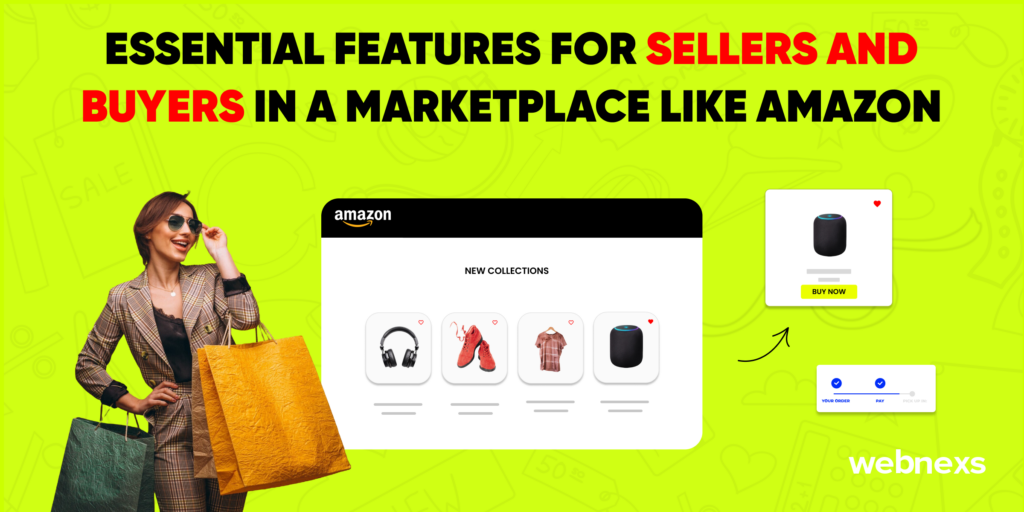
When creating a multi vendor marketplace website like amazon, it’s crucial to offer a comprehensive set of features that cater to both sellers and buyers.
These features should not only improve their experience but also boost the marketplace’s overall performance, ensuring the business success.
Here’s a detailed breakdown of essential features for sellers and buyers to consider for make a website like amazon that works for everyone involved.
Key Features for Sellers
1. Vendor Management System (VMS)
A strong Vendor Management System (VMS) is the backbone of your multi vendor marketplace. It enables sellers to manage their operations smoothly, allowing them to focus more on growing their business and less on logistics.
- Vendor Registration and Approval
Streamline the registration process by providing a secure and simple onboarding flow. You can offer automated or manual approval options to maintain quality control, ensuring that only trustworthy vendors are allowed to sell on the platform.
Tip – Use verification systems, such as ID or business registration checks, to enhance the credibility of your vendors.
- Vendor Dashboard
Empower sellers with a centralized dashboard that provides real-time insights into their sales, product performance, and customer interactions.
Valuable Information – A data-driven dashboard should include analytics on product views, conversions, and order history. This transparency helps vendors understand their business and make informed decisions.
2. Commission and Payment Systems
Offering flexible and transparent commission structures helps vendors understand their costs and motivates them to stay engaged on the platform.
- Flexible Commission Structure
Tailor the commission rate based on the vendor’s performance, product category, or even special promotions.
Valuable Information – Consider offering tiered commissions that reward high-performing vendors, encouraging them to scale their operations on your ecommerce website like Amazon.
- Automated Commission Calculation
Automate the commission calculations on each sale to ensure vendors receive accurate payments.
Tip – This automation minimizes errors and administrative work for both parties, increasing trust and efficiency.
- Multiple Payment Gateways
Provide a range of payment methods, from credit cards to digital wallets and local payment options, to cater to vendors globally.
Valuable Information – Ensure payment systems are secure, minimizing friction in the transaction process.
- Escrow System
Secure the buyer’s payment in an escrow account until the product is delivered, ensuring trust between both vendors and buyers.
Valuable Information – This reduces disputes and fraud risks, enhancing the overall shopping experience.
3. Product and Category Management
Efficient product and inventory management can make or break a vendor’s success in a ecommerce marketplace.
- Product Categorization
Make it easier for customers to find products by providing an intuitive system for product categorization.
Tip – Include subcategories and detailed filters, helping vendors organize their listings and shoppers to find what they need quickly.
- Inventory Management
Help vendors stay on top of their stock with inventory tracking and automated alerts when stock is low.
Valuable Information – Real-time stock updates prevent over-selling and increase customer satisfaction by ensuring availability.
- Product Search and Filters
Integrate advanced search filters, allowing buyers to search by price range, ratings, brands, etc., making it easier for vendors to attract the right audience.
Tip – Offer features like autocomplete search to enhance the search experience.
4. Order and Shipping Management
Keeping both vendors and buyers informed about order statuses enhances customer experience and builds trust.
- Order Tracking
Enable real-time order tracking, providing both the vendor and buyer with updates on the product’s journey.
Valuable Information – Ensure vendors receive alerts for every order update so they can fulfill orders promptly.
- Shipping Integration
Integrate with third-party shipping carriers to provide seamless order fulfillment.
Tip – Use shipping calculators to give buyers clear shipping cost estimations.
- Shipping Rules and Zones
Allow vendors to set customized shipping rules based on geographic zones to avoid confusion.
Valuable Information – Implement international shipping options, allowing vendors to expand their reach beyond local customers.
- Automated Tax Calculation
Automatically calculate taxes based on the buyer’s and seller’s locations, simplifying the tax process.
Tip – This feature is especially important for global marketplaces, ensuring compliance with different tax regulations.
Here are some interesting facts about Amazon’s seller features
Do you know?
Global Reach – According to sell.amazon, As of 2024, Amazon has over 1.9 million active sellers globally, with access to millions of customers across 200+ countries.
Key Features for Buyers
1. Customer Profiles
Buyers should be able to personalize their experience, ensuring convenience and customized recommendations.
- Personalized Dashboards
Let customers save order history, preferences, and payment information, making their future purchases quicker and more convenient.
Valuable Information – Use this data to recommend products, driving repeat purchases and increasing lifetime customer value.
2. Wishlist and Notifications
Help customers keep track of their desired items while encouraging return visits.
- Wishlist Creatio
Allow customers to add items to wishlists and receive notifications when those items go on sale or are restocked.
Valuable Information – Offer exclusive discounts or early access to wishlist products, encouraging customers to make a purchase.
3. Customer Reviews and Rating
- Reviews are a key trust signal. Enable buyers to leave feedback, helping others make informed decisions.
Review System
Allow buyers to rate products and leave detailed reviews.
Valuable Information – Verified purchase badges give reviews more weight and increase the credibility of the feedback. Additionally, incentivize customers to leave reviews by offering loyalty points.
4. Order and Shipping Management
Transparent order tracking and flexible shipping options create a positive buying experience.
- Order Tracking
Keep customers informed with real-time order tracking from the moment of purchase to delivery.
Valuable Information – Integrate notifications for shipping updates, estimated delivery times, and delays.
- Shipping Rules and Zones
Provide clear visibility on shipping costs based on customer locations, including international shipping options.
Tip – Offer flat-rate shipping for specific regions to simplify costs for buyers.
5. Seamless Mobile Experience
A large number of users shop on mobile devices, so it’s essential to offer a smooth, mobile-optimized experience.
- Responsive Design
Ensure your marketplace is fully optimized for smartphones and tablets, providing an intuitive and smooth shopping experience across devices.
Valuable Information – Use mobile-friendly checkouts and push notifications to keep buyers engaged.
At Webnexs, we specialize in providing multi vendor ecommerce website like amazon that encompass all of these features and more.
Challenges in Building an Amazon-Like Website
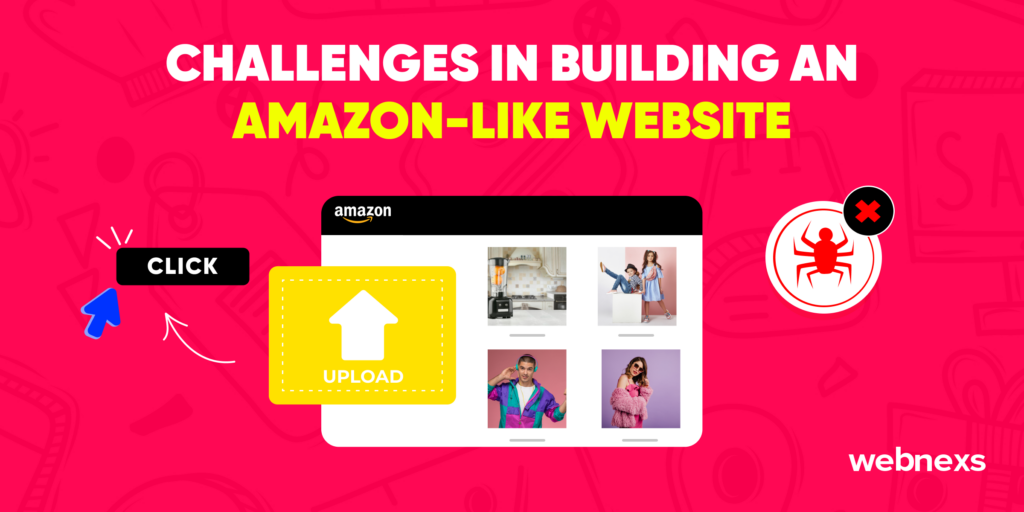
Creating a website like amazon that rivals Amazon requires more than just technological infrastructure.
The path is filled with numerous challenges that demand strategic planning, innovative problem-solving, and a deep understanding of the ecommerce ecosystem.
Below, we outline the critical hurdles businesses face and offer actionable insights to navigate them effectively.
1. Dominating Competition
Making a website like Amazon means competing with established ecommerce giants. With Amazon’s dominant market position, brand reputation, and loyal customer base,
Challenge
Competing with platforms like Amazon, which dominate the market with their scale, reputation, and customer loyalty, requires significant effort. New entrants often struggle to carve a niche and attract a sizable customer base.
Solution
- Differentiate Your Brand
Offer unique value propositions like exclusive products, faster delivery, or exceptional customer service.
- Invest in Marketing
Leverage SEO, PPC, and content marketing to boost visibility and reach your target audience effectively.
- Collaborate with Niche Vendors
Partnering with specialized vendors can give you a competitive edge by offering products not found elsewhere.
2. Balancing Buyer and Seller Satisfaction
Building a successful online shopping website like Amazon means meeting the needs of both buyers and sellers.
Challenge
Meeting buyers’ demands for quality, price, and delivery speed while addressing sellers’ needs for fair treatment and profitability is challenging.
Solution
- Transparent Policies
Clearly define platform rules and guidelines to ensure fairness for all parties.
- Data Insights for Sellers
Provide sellers with analytics to help them optimize their performance.
- Customer Feedback Loops
Actively gather feedback from buyers to improve services and address pain points.
3. Ensuring Platform Security and Preventing Fraud
Online marketplaces, such as an ecommerce website like Amazon, are prime targets for fraud, cyberattacks, and data breaches.
Challenge
Protecting sensitive customer data, preventing fraudulent activities, and ensuring secure transactions are critical for building trust.
Solution
- Strong Encryption
Implement TLS/SSL encryption for secure data transmission.
- Fraud Detection Systems
Use machine learning to monitor and flag suspicious activities.
- Two-Factor Authentication (2FA)
Add extra layers of security for user accounts.
4. Keeping Up with Technology and Market Trends
staying up-to-date with new tools and trends is essential to staying competitive and meeting the needs of both buyers and sellers in a multi vendor marketplace website like Amazon
Challenge
Staying ahead of emerging trends like AI-driven personalization, voice commerce, and blockchain requires continuous investment and innovation.
Solution
- Regular Upgrades
Periodically review and upgrade platform features to stay relevant.
- Adopt AI Tools
Use AI to enhance search capabilities, provide personalized recommendations, and optimize inventory management.
- Monitor Competitors
Keep track of competitors’ technology and market strategies to identify opportunities for innovation.
5. Seasonal Demand Fluctuations
Handling seasonal spikes and dips in demand is a significant challenge for any ecommerce platform.
Challenge
High-volume shopping seasons like Black Friday or Christmas can overwhelm the system, while off-seasons may lead to underutilized resources.
Solution
- Scalable Infrastructure
Use cloud-based systems to scale resources up or down as needed.
- Seasonal Marketing Campaigns
Promote seasonal sales or exclusive deals to drive traffic during off-peak times.
- Inventory Planning
Work closely with vendors to ensure adequate stock levels during peak seasons.
Building a marketplace that mirrors Amazon’s success requires overcoming significant challenges with innovative solutions. By addressing these challenges strategically, you can create a reliable and competitive marketplace that attracts buyers and sellers alike.
Read More: Top 10 Ecommerce Website Mistakes To Avoid While Building an Online Platform
Amazon vs Competitors: Why Amazon Dominates

Before Amazon became the king of online shopping, many other ecommerce platforms were already competing in the ecommerce space. But despite being early to the game, they couldn’t keep up with Amazon’s rapid growth and dominance.
Let’s take a look at some of the early ecommerce website names and platforms,
Early Competitors
- eBay, Founded in 1995, eBay was one of the first online marketplaces. It started as an auction site, allowing individuals to buy and sell goods.
- Toys “R” Us, This beloved toy store chain was founded in 1948 and launched its ecommerce platform in 2000. It was one of the first brick-and-mortar stores to venture into online shopping.
- Yahoo! Shopping, Launched in 1998, Yahoo! Shopping was an early ecommerce platform that allowed users to search and buy products from various online stores.
Why Early Competitors Fell Behind
Despite being pioneers in ecommerce, these platforms couldn’t keep up with Amazon’s growth. Here’s why
- eBay
While eBay was successful as an auction site, it struggled to adapt to the changing ecommerce environment. It didn’t offer a smooth shopping experience, and its focus limited its appeal.
- Toys “R” Us
Although Toys “R” Us was a beloved brand, its ecommerce platform was slow to take off. It relied heavily on Amazon to handle its online sales, which limited its control and profitability.
- Yahoo! Shopping
Yahoo! Shopping’s platform was overcrowded and difficult to navigate. It also relied on third-party sellers, which made it hard to ensure a consistent shopping experience.
while competitors struggle to catch up? Amazon has stayed at the top of ecommerce by using smarter strategies than competitors. By focusing on better tools, wider product choices, and strong logistics, Amazon has secured its #1 spot.
Ready to explore? Let’s check out what Webnexs offers To make a multi vendor marketplace website like amazon.
Discover How to Make a Website Like Amazon Now!
Build a Multi Vendor Marketplace Website with Webnexs

In the world of multi vendor marketplaces, early competitors couldn’t keep up with Amazon due to a lack of advanced tools and features. Webnexs fills this gap, providing the tools and features needed to create a multi vendor marketplace website like Amazon
Now, how can Webnexs help you replicate this success?
With advanced features and tools, Webnexs equips you to build a strong platform that stays ahead of competitors.
Up next, let’s explore these features in a table format! And followed by the advantages and benefits of those features
Feature | Advantage | Benefit |
Storefront (Theme Customization) |
Customizable themes for better branding and design flexibility |
Provides a unique look and feel for your marketplace, enhancing the customer experience |
Reporting Modules |
Detailed analytics for tracking sales, performance, and customer behavior |
Helps businesses make data-driven decisions to optimize operations and growth. |
Inventory Management |
Ability to assign orders to specific stores for better tracking. |
Simplifies order management and reduces errors in shipping and fulfillment. |
Single Page Checkout |
Streamlined checkout process on a single page |
Reduces cart abandonment by offering a fast and convenient checkout experience |
Product Rating and Reviews |
Customers can rate and review products. |
Builds trust and credibility for products, helping customers make informed decisions |
Shipping Rule |
Set custom shipping rules based on regions, weight, or product type. |
Ensures accurate shipping costs, improving customer satisfaction and reducing issues |
Abandoned Cart and Email Template |
Automated email templates for abandoned cart reminders |
Increases sales by bringing back customers who left without completing the purchase |
Email Template and Invoice |
Customizable email templates and invoice generation |
Enhances customer communication and provides a professional touch |
Product Filters |
Allows customers to filter products based on various attributes |
Helps customers find what they’re looking for quickly, improving user experience. |
CMS Page |
Easily manage content pages like About Us, Contact, etc |
Improves website content management and allows for easy updates |
Tax Calculations |
Automated tax calculation based on location and product type |
Ensures accurate tax collection and compliance with local tax laws. |
Product Variations |
Supports variations like size, color, or style for each product |
Provides customers with more choices, leading to higher satisfaction and sales. |
Digital Goods (Downloadable) |
Ability to sell downloadable products like eBooks or software. |
Expands product offerings and allows businesses to sell non-physical goods |
Vendor-Wise Product Listing |
Vendor-specific product listings in the product section. |
Makes it easier for customers to browse products by specific vendors |
Bulk Uploading System |
Ability to import products in bulk using CSV files |
Saves time and effort when adding large quantities of products |
Logs for Orders |
Tracks the transition of orders from payment to delivery and return. |
Provides clear visibility into order status, reducing errors and improving customer satisfaction |
Return Management System |
Manages and tracks product returns. |
Simplifies the return process for customers and improves operational efficiency |
Vendor Commissions |
Set commission rates for vendors based on sales |
Ensures fair compensation for vendors and motivates them to perform better |
Scanned Documents Uploading |
Vendors can upload scanned documents like VAT, GST, CIN from the backend |
Provides seamless document management for vendor verification and compliance |
Order-Wise Payouts |
Displays order details and allows batch payments |
Simplifies payout processing for administrators and vendors. |
Social Sharing on the Website |
Enables social media sharing of products. |
Increases product visibility and drives traffic to the website through social media |
Coupons |
Provides the ability to offer discount coupons |
Encourages sales and customer retention through special offers |
Multi-Currency |
Supports multiple currencies for international transactions |
Expands your marketplace’s reach globally and accommodates international buyers |
Default Store Currency |
Set a default currency for the store |
Provides a consistent experience for customers by displaying prices in their local currency |
Order Placement from Backend |
Allows orders to be placed manually from the admin panel, POS, and vendor panel. |
Offers flexibility for order management in different environments. |
Header & Footer Menu Settings |
Customize header and footer menus for easy navigation |
Improves website navigation and enhances the customer browsing experience. |
SEO |
Built-in SEO tools for better visibility in search engines. |
Increases organic traffic to the website, improving visibility and sales. |
Payment Gateways |
Integrated payment gateways like Razorpay and Stripe |
Provides secure and flexible payment options for customers, improving conversion rates |
Shipping Gateway |
Integrated shipping gateways like Shiprocket |
Simplifies the shipping process and ensures reliable delivery tracking |
Delivery Restrictions Module |
Set delivery restrictions based on PIN codes |
Prevents orders from being placed to restricted locations, ensuring smoother operations |
Multiple Products for a Single Vendor |
Allows vendors to list multiple products. |
Increases product variety and potential sales per vendor |
In-Stock Notifier |
Notifies customers when out-of-stock products become available. |
Increases customer satisfaction by ensuring they don’t miss products they want to buy |
Geo Location |
Automatically detects customer location for better service |
Provides a personalized experience by showing location-specific information |
Find and Earn Event Plugin |
Set up events where customers can find and earn rewards |
Encourages customer participation and drives engagement with special events |
Google and Facebook Product Feed |
Sync product listings with Google and Facebook for advertising. |
Expands reach by promoting products on major advertising platforms. |
Page Settings for Shop, Product, Category, Cart and Checkout |
Customize pages for better user experience and conversion. |
Optimizes the shopping process, improving both conversion rates and customer satisfaction |
Upsell and Cross-Sell Product Display |
Display related products for upselling or cross-selling |
Increases revenue by encouraging customers to buy additional products |
POS |
Point of Sale system for in-store transactions |
Increases revenue by encouraging customers to buy additional products |
Mobile App Updates |
Regular updates for mobile apps to improve functionality |
Keeps the mobile experience up to date and enhances customer satisfaction. |
Conclusion
In this blog, we’ve provided a comprehensive guide on how to create a multi vendor marketplace like Amazon, To make it even easier to follow, it’s helpful to break down each step, give real examples, and connect them to the features of Webnexs. By explaining how Webnexs tools can solve problems like the ones Amazon faces, readers will better understand how to use these strategies.
If you want to build a website like Amazon, create an ecommerce demo website, or start your own Amazon-like marketplace, Webnexs can help you with expert advice and the right tools. If you have questions or need help on how to create an online marketplace like Amazon, feel free to contact us.
Get in touch with us today to see how Webnexs can help you create a strong and successful ecommerce platform like Amazon that works for both buyers and sellers.






4 Responses
This article provides a comprehensive guide on building an ecommerce marketplace website like Amazon. The 8 step-by-step approaches are very helpful.
Your dedication to your readers is admirable. Helpful blog for all who wishes to build website like amazon.
This blog how to make a website like amazon exactly what I was looking for. Relevant!! Finally I’ve found something that helped me. Appreciate it!
Hello my loved one I want to say that this post is amazing great written and include almost all significant information regarding how to make online shopping website like amazon. I would like to look extra posts like this.